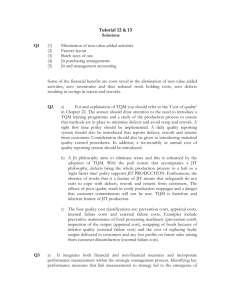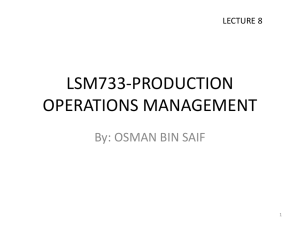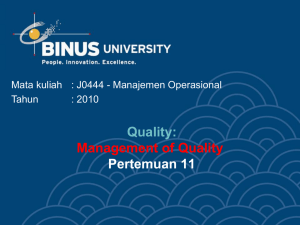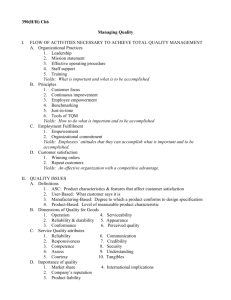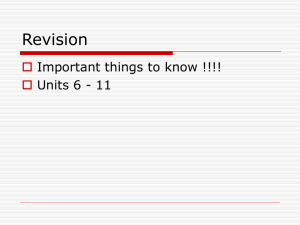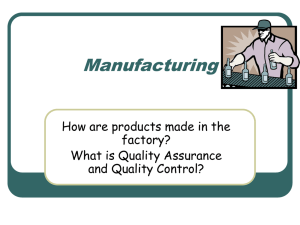Operations Management Managing Quality
advertisement
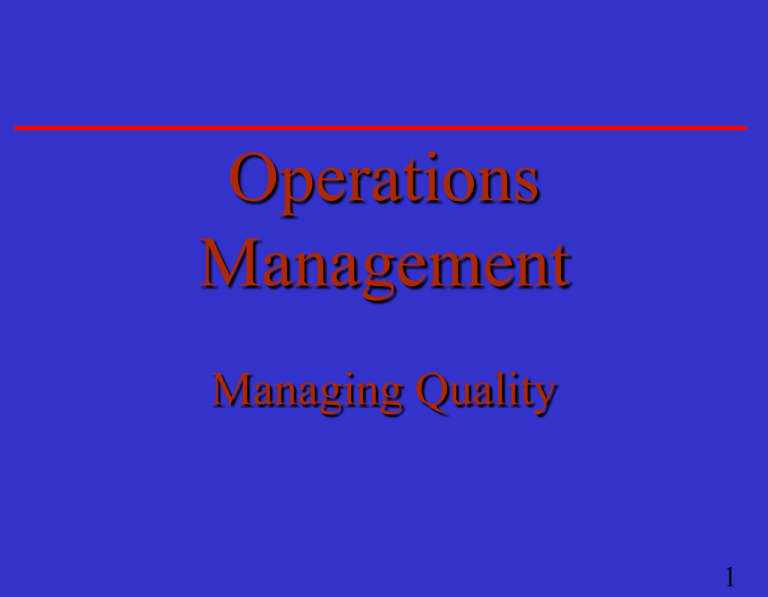
Operations Management Managing Quality 1 Learning Objectives ¨ Identify or define: Quality ¨ Malcolm Baldrige National Quality Awards ¨ Demings, Juran, and Crosby ¨ Taguchi Technique ¨ 2 Learning Objectives - continued ¨ Describe or Explain: ¨ ¨ ¨ ¨ ¨ ¨ ¨ Why quality is important Total Quality Management (TQM) House of Quality Pareto charts Process charts Quality robust products Inspection 3 To Make the Quality Focus Work Motorola: ¨ ¨ ¨ Aggressively began a worldwide education program to be sure that employees understood quality and statistical process control Established goals Established extensive employee participation and employee teams 4 Ways in Which Quality Can Improve Productivity Market Gains ¨ ¨ Improved Quality ¨ Improved response Economies of Scale Improved reputation Reduced Costs ¨ ¨ ¨ Increased Profits Increased productivity Lower rework and scrap costs Lower warranty costs 5 Flow of Activities Necessary to Achieve Total Quality Management ¨ Organizational Practices ¨ Quality Principles ¨ Employee Fulfillment ¨ Customer Satisfaction 6 Organizational Practices ¨ Leadership ¨ Mission statement ¨ Effective operating procedure ¨ Staff support ¨ Training Yields: What is important and what is to be accomplished 7 Quality Principles ¨ Customer focus ¨ Continuous improvement ¨ Employee empowerment ¨ Benchmarking ¨ Just-in-time ¨ Tools of TQM Yields: How to do what is important and to be accomplished 8 Employment Fulfillment ¨ Empowerment ¨ Organizational commitment Yields: Employees attitudes that can accomplish what is important and to be accomplished 9 Customer Satisfaction ¨ Meeting customer needs ¨ Repeat customers Yields: An effective organization with a competitive advantage 10 Definitions of Quality ¨ ASQC: Product characteristics & features that affect customer satisfaction ¨ User-Based: What consumer says it is ¨ Manufacturing-Based: Degree to which a product conforms to design specification ¨ Product-Based: Level of measurable product characteristic 11 Dimensions of Quality for Goods ¨ ¨ ¨ ¨ ¨ ¨ Operation Reliability & durability Conformance Serviceability Appearance Perceived quality Quality 12 Three Reasons Quality is Important ¨ Company reputation ¨ Product liability ¨ Global implications 13 Importance of Quality ¨ Costs & market share ¨ Company’s reputation ¨ Product liability ¨ International implications Market Gains Reputation Volume Price Improved Quality Increased Profits Lower Costs Productivity Rework/Scrap Warranty 14 International Quality Standards ¨ Industrial Standard Z8101-1981 (Japan) ¨ Specification for TQM ¨ ISO 9000 series (Europe/EC) ¨ Common quality standards for products sold in Europe (even if made in U.S.) ¨ ISO 14000 series (Europe/EC) ¨ Standards for recycling, labeling etc. ¨ ASQC Q90 series; MILSTD (U.S.) 15 Malcom Baldridge National Quality Award ¨ Established in 1988 by the U.S. government ¨ Designed to promote TQM practices ¨ Some criteria ¨ ¨ Senior executive leadership; strategic planning; management. of process quality Quality results; customer satisfaction ¨ Recent winners ¨ Corning Inc.; GTE; AT&T; Eastman Chemical. 16 EC Environmental Standard ISO 14000 Core Elements: ¨ ¨ ¨ ¨ ¨ Environmental management Auditing Performance evaluation Labeling Life-cycle assessment 17 Traditional Quality Process (Manufacturing) Customer Marketing Engineering Operations Specifies Need Interprets Need Designs Product Produces Product Defines Quality Plans Quality Quality is customer driven! Monitors Quality 18 TQM Encompasses entire organization, from supplier to customer Stresses a commitment by management to have a continuing company-wide drive toward excellence in all aspects of products and services that are important to the customer. 19 Achieving Total Quality Management Customer Satisfaction Effective Business Employee Fulfillment Quality Principles Organizational Practices Attitudes (e.g., Commitment) How to Do What to Do 20 Concepts of TQM ¨ ¨ ¨ ¨ ¨ Continuous improvement Employee empowerment Benchmarking Just-in-time (JIT) Knowledge of tools 21 Continuous Improvement ¨ Represents continual improvement of process & customer satisfaction ¨ Involves all operations & work units ¨ Other names ¨ ¨ ¨ Kaizen (Japanese) Zero-defects Six sigma 22 Employee Empowerment ¨ Getting employees involved in product & process improvements ¨ 85% of quality problems are due to process & material ¨ Techniques ¨ ¨ ¨ © 1995 Corel Corp. Support workers Let workers make decisions Build teams & quality circles 23 Quality Circles ¨ Group of 6-12 employees from same work area ¨ Meet regularly to solve work-related problems ¨ 4 hours/month ¨ Facilitator trains & helps with meetings 24 Deming’s Fourteen Points 1. 2. 3. 4. 5. Create consistency of purpose Lead to promote change Build quality into the products Build long term relationships Continuously improve product, quality, and service 6. Start training 7. Emphasize leadership 25 Deming’s Points - continued 8. 9. 10. 11. 12. 13. Drive out fear Break down barriers between departments Stop haranguing workers Support, help, improve Remove barriers to pride in work Institute a vigorous program of education and self-improvement 14. Put everybody in the company to work on the transformation 26 Benchmarking Selecting best practices to use as a standard for performance ¨ ¨ ¨ ¨ ¨ Determine what to benchmark Form a benchmark team Identify benchmarking partners Collect and analyze benchmarking information Take action to match or exceed the benchmark 27 Resolving Customer Complaints ¨ ¨ ¨ ¨ ¨ Make it easy for clients to complain Respond quickly to complaints Resolve complaints on the first contact Use computers to manage complaints Recruit the best for customer service jobs 28 Just-in-Time (JIT) Relationship to quality: ¨ ¨ ¨ JIT cuts cost of quality JIT improves quality Better quality means less inventory and better, easier-to-employ JIT system 29 Just-in-Time (JIT) ¨ ‘Pull’ system of production/purchasing ¨ Customer starts production with an order ¨ Involves ‘vendor partnership programs’ to improve quality of purchased items ¨ Reduces all inventory levels ¨ Inventory hides process & material problems ¨ Improves process & product quality 30 Just-In-Time (JIT) Example Work in process inventory level (hides problems) Unreliable Vendors Scrap Capacity Imbalances 31 Just-In-Time (JIT) Example Reducing inventory reveals problems so they can be solved. Unreliable Vendors Scrap Capacity Imbalances 32 Tools for TQM 1. Quality Function Deployment House of Quality 2. 3. 4. 5. 6. 7. Taguchi technique Quality loss function Pareto charts Process charts Cause-and-effect diagrams Statistical process control 33 Quality Function Deployment (QFD) ¨ Determines what will satisfy the customer ¨ Translates those customer desires into the target design 34 Quality Function Deployment ¨ Product design process using cross-functional teams ¨ Marketing, engineering, manufacturing ¨ Translates customer preferences into specific product characteristics ¨ Involves creating 4 tabular ‘Matrices’ or ‘Houses’ ¨ Breakdown product design into increasing levels of detail 35 To Build House of Quality ¨ Identify customer wants ¨ Identify how the good/service will satisfy customer wants. ¨ Relate the customer’s wants to the product’s hows. ¨ Identify relationships between the firm’s hows. ¨ Develop importance ratings ¨ Evaluate competing products 36 House of Quality Sequence Customer Requirements Design Characteristics Design Characteristics Specific Components Specific Components Production Process House 3 Production Process Quality Plan House 4 House 2 House 1 37 Taguchi Techniques ¨ Experimental design methods to improve product & process design ¨ Identify key component & process variables affecting product variation ¨ Taguchi Concepts ¨ ¨ ¨ Quality robustness Quality loss function Target specifications 38 Quality Robustness ¨ Ability to produce products uniformly regardless of manufacturing conditions ¨ Put robustness in House of Quality matrices besides functionality © 1995 Corel Corp. © 1984-1994 T/Maker Co. 39 Quality Loss Function ¨ Shows social cost ($) of deviation from target value ¨ Assumptions ¨ ¨ Most measurable quality characteristics (e.g., length, weight) have a target value Deviations from target value are undesirable ¨ Equation: L = D2 • C ¨ L = Loss ($); D = Deviation; C = Cost 40 Quality Loss Function Graph Loss = (Actual X - Target)2 • (Cost of Deviation) Loss LSL Greater deviation, more people are dissatisfied, higher cost T a rge t Lower (upper) specification limit USL X Measurement 41 Quality Loss Function Example The specifications for the diameter of a gear are 25.00 ± 0.25 mm. If the diameter is out of specification, the gear must be scrapped at a cost of $4.00. What is the loss function? © 1984-1994 T/Maker Co. 42 Quality Loss Function Solution ¨ L = D2 • C = (X - Target)2 • C ¨ L = Loss ($); D = Deviation; C = Cost ¨ 4.00 = (25.25 - 25.00)2 • C ¨ Item scrapped if greater than 25.25 (USL = 25.00 + 0.25) with a cost of $4.00 ¨ C = 4.00 / (25.25 - 25.00)2 = 64 ¨ L = D2 • 64 = (X - 25.00)2 • 64 ¨ Enter various X values to obtain L & plot 43 Target Specification Example A study found U.S. consumers preferred Sony TV’s made in Japan to those made in the U.S. Both factories used the same designs & specifications. The difference in quality goals made the difference in consumer preferences. Freq. LSL Japanese factory (Target-oriented) Target USL U.S. factory (ConformanceX oriented) 44 Pareto Analysis of Wine Glass Defects Frequency (number) 70 60 50 54 40 30 20 12 10 5 4 0 2 Scratche s Porosity Nicks Contamination Misc 72% 16% 5% 4% 3% Causes, by percent of total defects 45 Process Chart ¨ Shows sequence of events in process ¨ Depicts activity relationships ¨ Has many uses ¨ ¨ ¨ ¨ Identify data collection points Find problem sources Identify places for improvement Identify where travel distances can be reduced 46 Process Chart Example SUBJECT: Request tool purchase Dist (ft) Tim e (m in) Sym bol Description D W rite order On desk 75 D To buyer D Exam ine ¡ = Operation; ð = Transport; o = Inspect; D = Delay; Ñ = Storage 47 Cause and Effect Diagram ¨ Used to find problem sources/solutions ¨ Other names ¨ Fish-bone diagram, Ishikawa diagram ¨ Steps ¨ ¨ ¨ Identify problem to correct Draw main causes for problem as ‘bones’ Ask ‘What could have caused problems in these areas?’ Repeat for each sub-area. 48 Cause and Effect Diagram Example Problem Too many defects 49 Cause and Effect Diagram Example Method Manpower Main Cause Too many defects Material Machinery Main Cause 50 Cause and Effect Diagram Example Method Manpower Drill Over Time Too many defects Wood Steel Material Lathe Machinery Sub-Cause 51 Cause and Effect Diagram Example Method Manpower Tired Drill Over Time Slow Old Wood Steel Material Too many defects Lathe Machinery 52 Statistical Process Control (SPC) ¨ Uses statistics & control charts to tell when to adjust process ¨ Developed by Shewhart in 1920’s ¨ Involves ¨ ¨ ¨ Creating standards (upper & lower limits) Measuring sample output (e.g. mean wgt.) Taking corrective action (if necessary) ¨ Done while product is being produced 53 Statistical Process Control Steps Start Produce Good Provide Service Take Sample No Assign. Causes? Yes Inspect Sample Stop Process Create Control Chart Find Out Why 54 Control Chart Example UCL 11 Time 9 7 5 LCL 3 1 80 60 40 20 0 X 55 Inspection ¨ Involves examining items to see if an item is good or defective ¨ Detect a defective product ¨ Does not correct deficiencies in process or product ¨ Issues ¨ ¨ When to inspect Where in process to inspect 56 When and Where to Inspect ¨ At the supplier’s plant while the supplier is producing ¨ At your plant upon receipt of goods from the supplier ¨ Before costly or irreversible processes ¨ During the step-by-step production processes ¨ When production is complete ¨ Before shipment from your plant ¨ At the point of customer contact 57 When and Where to Inspect in Services Business Where Variable Bank Teller station Checking Speed, courtesy Accuracy Store Stockrooms Display areas Counters Stock rotation Attractiveness Courtesy, knowledge 58 TQM In Services ¨ Service quality is more difficult to measure than for goods ¨ Service quality perceptions depend on ¨ ¨ Expectations vs. reality Process & outcome ¨ Types of service quality ¨ ¨ Normal: Routine service delivery Exceptional: How problems are handled 59 Service Quality Attributes Reliability Responsiveness Tangibles Competence Understanding Access Security Courtesy © 1995 Corel Corp. Credibility Communication 60
